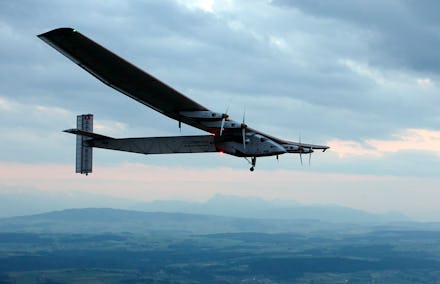This Solar Plane Is Flying Around the World Without Any Standard Fuel Sources

With a wingspan measuring 236 feet, a weight similar to that of a Dodge Durango and a maximum passenger count of one, the Solar Impulse 2 isn't your typical plane. Then again, it's not embarking on a typical journey.
On Monday, the funky little plane took off from Abu Dhabi, marking the first step in a momentous adventure: Over the next five months, the Swiss-engineered aircraft will attempt to become the first plane powered entirely by solar energy to fly around the world.
"What better way to demonstrate the importance of the pioneering, innovatory spirit than by achieving 'impossible' things with renewable energy and highlighting new solutions for environmental problems?" the project's website says.
Solar Impulse 2 — the first iteration became the first solar-powered plane to fly overnight in 2009 — will be captained by André Borschberg and Bertrand Piccard, the project's co-founders, who will alternate flying duties between each stop on the route.
Borschberg completed the first leg, and 12 hours after takeoff on Monday, the plane landed in Muscat, Oman, landing at 16:14 GMT, the BBC reported. It's also scheduled to make stops in India, Myanmar, China, New York City and Southern Europe or Northern Africa, before returning to Abu Dhabi this summer, according to the website.
However, given the mission's never-before-seen ambitions, the pilots are well aware of the difficulties ahead.
"For such an adventure, as for any premiere, there are no references. We were, and will be, faced with a number of challenges, leading us to push the limits of technological, human and piloting performance," they write on the website.
Why are they doing this? Besides the "neat-o" factor, the duo actually have a solid reason for the vaguely crackpot mission: They want flying — which isn't exactly the most eco-friendly form of transportation — to become much more energy-efficient.
"Solar Impulse's ambition is for the world of exploration and innovation to contribute to the cause of renewable energies, to demonstrate the importance of clean technologies for sustainable development; and to place dreams and emotions back at the heart of scientific adventure," the website reads.
By proving that it's possible to fly long distances using futuristic, energy efficient aircrafts, the two men are hoping to inspire real change in the aviation industry. Though there's still quite a way to go before this idea is feasible on a commercial scale — the trip will take five months and require many stops for maintenance — they hope that planting the seed will inspire similar kinds of innovation.
As the BBC points out, this kind of thinking isn't as crazy as it may seem. In September, for example, the International Energy Agency released a report predicting that solar power could replace fossil fuels as the biggest global source of electricity by 2050; given the declining prices of solar panels, the economic incentive alone could be enough.
It's about time. As countless reports have shown, fossil fuel consumption comes at a steep cost. It's a major contributor to climate change, and given our proclivity for using a whole heap of it, our habits have led to a sharp increase in the amount of greenhouse gases in the atmosphere.
Left unchecked, the effects of fossil fuel consumption on our environment has the potential for catastrophic consequences — oil spills, habitat destruction, pollution, acid rain and rising sea levels can all be traced back to excessive use of fossil fuels.
Solar Impulse 2 won't solve all these problems, of course, and even switching entirely to planes that use solar energy isn't enough by itself. But it does present a good jumping-off point — if only to get the wheels off the ground.